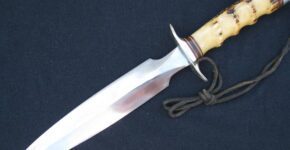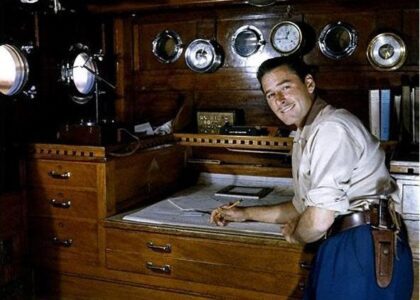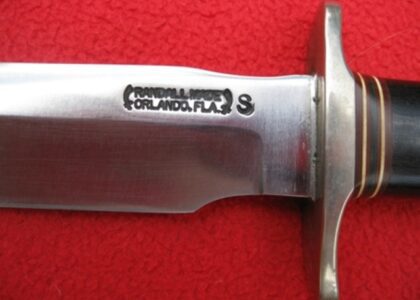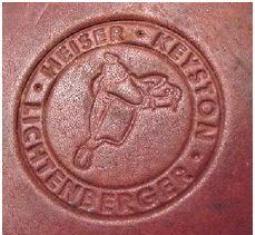

Originally in RKS Newletter #61 February 2004
My “Johnson Sheath Footnote” article in the last issue of the newsletter got a lot of conversation going on the Johnson brown button sheath “mystery”. I received many emails and several phone calls from collectors wanting to discuss the subject and give me their opinions, but mostly to ask questions. I am referring to individuals that I have had limited or not contact with prior to the article being published. It was interesting to say the least and I was pleased that there was some interest other than mine in old Johnson brown button sheaths.
There are a few things I want to say as a follow-up to last issues article that may help clarify a few things for some as well as a couple of additional thoughts. I wasn’t to reiterate that I am only making a case for Johnson producing sheaths for Randall prior to the generally accepted time frame of 1962. I am not saying it is a fact but certainly plausible.
The single most important item as far as anyone knows is Randall never supplied Heiser with their logo stamp. Similarly, there is no evidence that Heiser ever used anything other than their own logo on any of their leather products (which were many) including sheaths for Randall knives. Randall knife sheaths were not Heiser’s main stay in the leather business and there would really be no incentive for them to change the business practice that had been in existence for many years of marking their leather products with their own logo.
Secondly, if in fact Heiser supplied sheaths to Randall beyond 1962 you would have to assume Heiser marked sheaths would be found on popular mid-1960’s models. Where are they? I spoke with Greg Gutcher about the transition of sheath makers and he said at the time of Johnny Johnson’s passing, Greg was producing approximately 40% to 45% of Randall’s sheaths. The level of production was reached after approximately five years of involvement with Randall. The point I am making is even under different circumstances, I would think the transition between Heiser and Johnson would have taken at least a year or two if not longer. I just don’t think it was a decision (changing from Heiser to Johnson) that some dismiss as being as dimple as turning a light switch on and off. “You are not our sheath maker as of today; we have a new guy staring tomorrow”. Hardly would seem the case.
It is a fact that Heiser never used the baby-dot snaps that were introduced by Johnson sometime in late 1962 or early 1963 (Gaddis pg 225). If we follow this proposed timeline on the “discovery’ of Maurice Johnson in the spring/summer of 1962 and the switch to baby dot snaps as mentioned, then we can extrapolate the Johnson only made brown button sheath for only four to six months or so. I don’t know if it is the case or not but brings me again to ask, where are the mid-1960’s brown button Heiser sheaths? This applies to even sheaths that “look” like a Heiser and may be Randall marked. According to Gaddis, Heiser was still supplying sheath well into the mid 1960’s, so you should have been able to get a Johnson baby-dot fastener or a brown button Heiser sheath for several years at the same time. The brown button sheath was all but gone in 1963 and as I mentioned in last issues’ article, the only Heiser marked sheaths you see form the period are a couple of the least popular (quantity made) models in the Randall line i.e. the big Bowie knives and the Arkansas toothpick.
One interesting development occurred since the last newsletter that pertains to the topic at hand. A set of four brown micarta knives with at least two of them marked 1950 of the reverse of the sheath showed up on the Randall “grapevine”. The knives originally came from one individual. Three of the sheaths are Randall marked with a horizontal logo orientation and the fourth is in a Heiser sheath. Now this set of knives and sheaths of mixed logos and being of the same vintage lend themselves to my theory that Johnson may have been involved a couple of years prior that generally accepted. According to Gadddis, there were a limited umber of sheaths produced in the 1959-1960 time frame for the Ward Gay special by whom Gaddis refers to as a harness maker – a Mr. Stockman – but it doesn’t seem as though it was a long-lived affair. However, Gaddis states that there were three different harness makers known to be involved with Randall at one time or another in those days so Johnson could have been one of them. Unfortunately, even as I present these scenarios, it seems no one really knows the answer.
I think this issue can be viewed three ways. First, Johnson was involved with Randall prior to 1962 and initially did an excellent job of replicating Heiser sheaths. Before his “style” of sheath evolved into what we call a Johnson “rough back”. Second, Randall supplied Heiser with a logo stamp or Heiser shipped unmarked sheaths to the Randall shop and there were stamped there. This would be an easy was to explain away some of these sheaths but no one can recall this happening and apparently Gaddis found no written record of such nor was he told by Bo this occurred. Also, it still doesn’t explain the lack of mid 1960’s brown button sheaths from Heiser. Third, there was a “phantom” sheath maker no one knows anything about yet supposedly supplied Randall with sheaths for several years. I do not subscribe to that theory as some do. I would wager this being the case, Gaddis would have come across this information also during his research and access to the Randall records in print form or verbally from Bo. It would have been too large a piece of Randall history for there not to be any records or no one having any recollection. Some have proposed the theory that the “phantom” sheath maker was actually Clarence Moore who became involved again and make sheath for a few years. It is possible but not likely as Moore had his own recognizable style of sheaths and again, there would be records.
In conclusion, the issue many never be full settled until access is again granted to the Randall records and the necessary information is found. In any case, apparently for now as far as collectors are concerned, brown button sheaths with the Randall logo will be referred to and accepted as Johnson sheaths.



